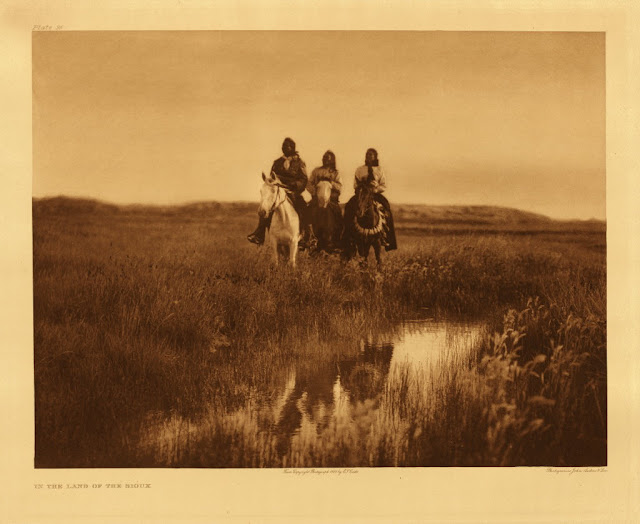.
From THE SOUL OF AN INDIAN
by Charles Alexander Eastman
(Ohiyesa)
.
.
[Charles Eastman was a Santee Sioux born in 1858.
Educated in white schools, he eventually received degrees
from Beloit College, Dartmouth, and Boston University
Medical School. He became an advisor to presidents
and worked actively to bring the voice of the Indian
into the American intellectual arena.
His story is fascinating, as are his writings.
Amazon has a large number of sellers with
books about and by Charles Eastman
(Ohiyesa was his Santee Sioux name);
used prices start at a penny plus shipping.]
books about and by Charles Eastman
(Ohiyesa was his Santee Sioux name);
used prices start at a penny plus shipping.]
The public religious rites of the Plains Indians
are few, and in large part of modern origin,
belonging properly to the so-called "transition period."
That period must be held to begin with the first
insidious effect upon their manners and customs
of contact with the dominant race, and many of
the tribes were so influenced long before they
ceased to lead the nomadic life.
.
.
The fur-traders, the "Black Robe" priests,
the military, and finally the Protestant missionaries,
were the men who began the disintegration of the
Indian nations and the overthrow of their religion,
seventy-five to a hundred years before they were forced
to enter upon reservation life. We have no authentic study
of them until well along in the transition period,
when whiskey and trade had already debauched
their native ideals.
.
During the era of reconstruction they modified
their customs and beliefs continually, creating a
singular admixture of Christian with pagan superstitions,
and an addition to the old folk-lore of disguised Bible
stories under an Indian aspect. Even their music shows
the influence of the Catholic chants. Most of the material
collected by modern observers is necessarily of
this promiscuous character.
.
.
It is noteworthy that the first effect of contact
with the whites was an increase of cruelty and
barbarity, an intensifying of the dark shadows
in the picture! In this manner the "Sun Dance"
of the Plains Indians, the most important of their
public ceremonials, was abused and perverted
until it became a horrible example of barbarism,
and was eventually prohibited by the Government.
.
.
In the old days, when a Sioux warrior
found himself in the very jaws of destruction,
he might offer a prayer to his father, the Sun,
to prolong his life. If rescued from imminent danger,
he must acknowledge the divine favor by making a
Sun Dance, according to the vow embraced in his
prayer, in which he declared that he did not fear
torture or death, but asked life only for the sake
of those who loved him. Thus the physical ordeal
was the fulfillment of a vow, and a sort of atonement
for what otherwise might appear to be reprehensible
weakness in the face of death. It was in the nature
of confession and thank-offering to the "Great Mystery,"
through the physical parent, the Sun, and did not
embrace a prayer for future favors.
.
.
barbarity, an intensifying of the dark shadows
in the picture! In this manner the "Sun Dance"
of the Plains Indians, the most important of their
public ceremonials, was abused and perverted
until it became a horrible example of barbarism,
and was eventually prohibited by the Government.
.
.
In the old days, when a Sioux warrior
found himself in the very jaws of destruction,
he might offer a prayer to his father, the Sun,
to prolong his life. If rescued from imminent danger,
he must acknowledge the divine favor by making a
Sun Dance, according to the vow embraced in his
prayer, in which he declared that he did not fear
torture or death, but asked life only for the sake
of those who loved him. Thus the physical ordeal
was the fulfillment of a vow, and a sort of atonement
for what otherwise might appear to be reprehensible
weakness in the face of death. It was in the nature
of confession and thank-offering to the "Great Mystery,"
through the physical parent, the Sun, and did not
embrace a prayer for future favors.
.
.












No comments:
Post a Comment